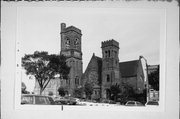Property Record
904 E KNAPP ST
Architecture and History Inventory
| Historic Name: | Saint Paul's Episcopal Church |
|---|---|
| Other Name: | ST. PAUL'S EPISCOPAL CHURCH |
| Contributing: | |
| Reference Number: | 27245 |
| Location (Address): | 904 E KNAPP ST |
|---|---|
| County: | Milwaukee |
| City: | Milwaukee |
| Township/Village: | |
| Unincorporated Community: | |
| Town: | |
| Range: | |
| Direction: | |
| Section: | |
| Quarter Section: | |
| Quarter/Quarter Section: |
| Year Built: | 1882 |
|---|---|
| Additions: | 1890 |
| Survey Date: | 1984 |
| Historic Use: | house of worship |
| Architectural Style: | Romanesque Revival |
| Structural System: | |
| Wall Material: | Sandstone |
| Architect: | Edward Townsend Mix |
| Other Buildings On Site: | |
| Demolished?: | No |
| Demolished Date: |
| National/State Register Listing Name: | Saint Paul's Episcopal Church |
|---|---|
| National Register Listing Date: | 12/27/1974 |
| State Register Listing Date: | 1/1/1989 |
| National Register Multiple Property Name: |
| Additional Information: | A 'site file' exists for this property. It contains additional information such as correspondence, newspaper clippings, or historical information. It is a public record and may be viewed in person at the State Historical Society, Division of Historic Preservation. DESIGN BASED ON RICHARDSON'S TRINITY CHURCH IN BUFFALO. HABS WI-271. Occupying one of the highest points in the neighborhood, this robust red sandstone church reigns over its surroundings. It illustrates asymmetrical massing; a low, ground-hugging profile; heavy, rock-faced masonry; round-arched windows; and massive, freestanding square towers. Its towers are crenelated, castle-style. Stepped-in compound arches surround deeply recessed portals, particularly the main entry on the south (Knapp Street) facade, emphasizing the fortress-like thickness of the stone walls. Facing Knapp Street, a rose window blooms above the main entry pavilion, and round-arched transept windows dominate the east and west facades. New York’s Louis Comfort Tiffany and Company crafted several these windows using a process, known only to Tiffany that cannot be replicated. The massive west transept window is reputedly one of the largest expanses of art glass that Tiffany ever created. Edward Townsend Mix’s design for St. Paul’s borrowed heavily from Boston architect Henry Hobson Richardson. The exterior strongly recalls Richardson's published but unexecuted 1872 design for Trinity Church in Buffalo, New York. St. Paul’s interior is reputedly based on Richardson’s Trinity Church in Boston. The floor plan is cruciform, with the nave oriented north-south, the baptistery occupying the west transept, and the morning chapel the east. St. Paul's parish is the city's oldest Episcopal congregation, founded in 1838 when Milwaukee was yet a small village. This building survived a serious fire in 1950, which gutted the north end and forced remodeling of the chancel, but spared the Tiffany glass and the intricately beamed ceiling in the nave and transepts. The church reopened in 1953. Recently, the church cleaned and restored its exterior and windows. |
|---|---|
| Bibliographic References: | MILWAUKEE HISTORIC BUILDINGS TOUR: YANKEE HILL, CITY OF MILWAUKEE DEPARTMENT OF CITY DEVELOPMENT, 1994. Cornerstone. Buildings of Wisconsin manuscript. |
| Wisconsin Architecture and History Inventory, State Historic Preservation Office, Wisconsin Historical Society, Madison, Wisconsin |





